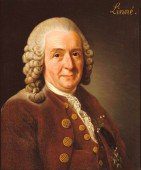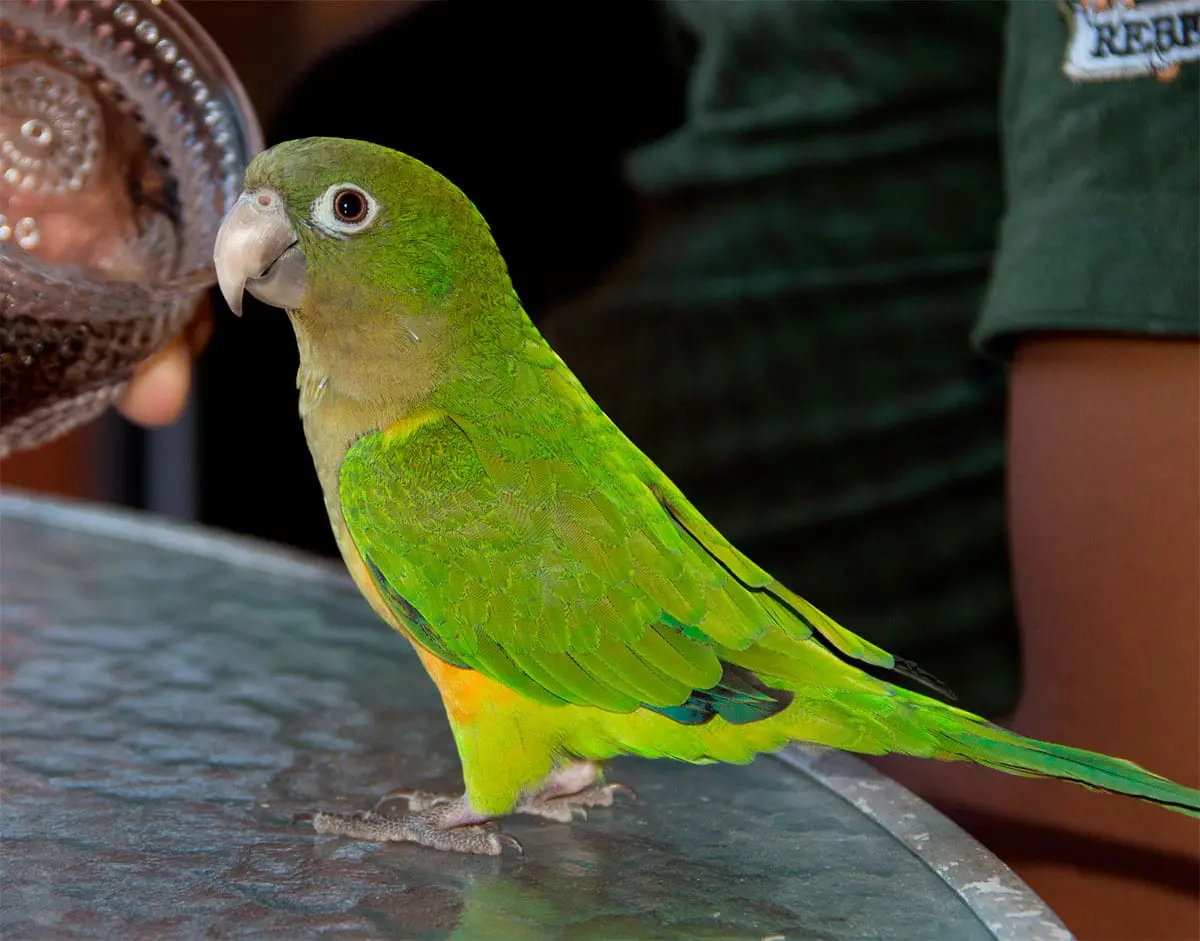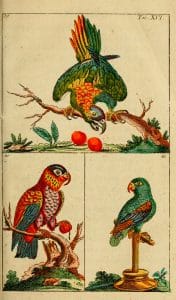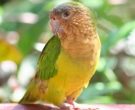Content |
|---|
Description:
Of 17 to 20 cm. length between 76 and 102 g. of weight.
The Brown-throated Parakeet (Eupsittula pertinax) it is a polytypic species. Its fourteen subspecies are distinguished by the mix yellow and Brown on his face and throat.
In the case of the Eupsittula pertinax aeruginosa, the lores previous, the frontal area, underside of cheeks, both sides of the neck and ear-coverts, are dark brown; dark stripes visible on the cheeks; the feathers of the ocular region are of color orange-yellow; the crown greenish blue. Upperparts olive green. Lesser and medium coverts green; bluish green the primaries and greater coverts. Primaries and secondaries green up, Blue dark on the tips, Blue them vane outer in the secondaries; by down dark grey. Underwing-coverts brighter yellowish green. The throat and the top chest dark brown; the underparts Matte yellowish green with an orange patch in the central area of the belly. For above, the tail is of color green blue, bluer towards the tip; undertail greyish-yellow.
The bill brownish-grey; bare periophthalmic yellowish white; irises yellow, legs grey.
Both sexes similar, without sexual dimorphism, where males are larger than females.
The youth they tend to lack intense yellow, that is alive in individuals adults. Its forecrown is dark greenish blue. The throat and the chest are greenish, while the belly is green with a bit of orange or yellow.
- Sound of the Brown-throated Parakeet.
Habitat:
Video – "Brown-throated Parakeet" (Eupsittula pertinax) |
|---|
The Aratinga Pertinaz occupies all kind of fields wooded open of the Savannah, transparent areas of dry scrubland full of cactus and acacias, forests of mangrove, tropical forests (where is the most abundant parrot species often), gallery and white sand forests, Mangroves of Rhizophora, edges of moist evergreen forests, and agricultural areas with palms and other trees.
Move at altitudes on the 1.200 m or more, Although they tend to stay below the 1.200 m. This Aratinga also lives in artificial clearings such as public parks or gardens..
In general, observed in flocks or pairs, forming larger groups where food is abundant and in communal roosts.
Reproduction:
The Brown-throated Parakeet It monogamous. With plays After the season of rains, in general from February to April. Birds very social, assess potential mates in large communal roosts. Also used strong calls in select to your mate / to.
Its breeding season It begins after the rainy season, and varies geographically between the months of February and September. Between February and April in Goal, Colombia; from February to April in Venezuela and any time of the year in Suriname, Curacao, Aruba and Bonaire.
When the conditions are favorable this species You can reproduce several times a year. Son colonial and have been observed up to seven pairs nesting next to each other.
Nest in the cavities of trees, artificial nesting boxes, or in arboreal termite. There are reports of nests made in cracks in rocks. The nests they are very simple, without any plant covering and the eggs, often, they are placed on the floor of the cavity nude. The number of eggs in a nest varies from two to seven.
The female is the primary incubator, with one incubation which can last thirty-six to thirty-seven days in the wild. The chicks they leave the nest after 50 days. The young join their parents and form small family groups that last until the parents begin a new breeding season..
Food:
The Brown-throated Parakeet consuming a wide variety of food, including, for example, in the Northwest of Venezuela seeds of Cassia, Peltophorum, Lagerstroemia and Cedrela, fruits of Muntingia, Swietenia, Psidium and Solanum as well as flowers of Tabebuia, Delonix, Eryihrina and Gliricidia.
Sometimes it causes damage to crops (for example, of millet and handle), of corn in Colombia and in fruit plantations of the Netherlands Antilles. Despite being considered pests in some areas, the Brown-throated Parakeet they are not strongly persecuted.
They feed in very vocal groups that often include macaws and amazon parrots.
Distribution:
The Brown-throated Parakeet are distributed to the North of South America, Panama and the islands of the Southern Caribbean.
In Panama are present in the slope of the peaceful, rarely on the side of the Caribbean, even in the canal area. But, they occupy the lowlands of the Northern Caribbean and northeast of Colombia, from the East of the Sinu River up to the Guajira peninsula, including the Center and low Magdalena valley, and observed at elevations more low in the East of the Andes and the lowlands of the South of the Alto Orinoco, to the North of Vaupés.
Probably can be observed in all Venezuela, extending to the Margarita Islands, Turtle (Venezuela), Curacao, Aruba and Bonaire (Netherlands Antilles); introduced in St Thomas, virgin islands, in the 19th century.
Its distribution extends through of the Guianas and the North of Brazil, from Roraima until Amapá, as well as discontinuously in the upper part of the basin of the Tapajos River, For and in the basin of the Black river, amazon.
In spite of his uneven distribution, usually common to abundant, in many places it is the most common parrot (for example in localities of Guyana), locally common in Panama and reportedly very common in black rivers and Branco, Brazil.
Your area of distribution possibly be increasing due to deforestation. In general resident with local seasonal movements (for example, in the region of Santa Maria, Colombia) the availability of food and the dispersion of the areas of reproduction-related.
Conservation:
• Red List category of the UICN current: Least concern
• Population trend: Growing
The Eupsittula Pertinax (Pit and neck of 2014) was considered, previously, belonging to the genus Aratinga.
The subspecies Griseipecta, endemic of the sinu valley in Colombia, There have been since 1949 and is likely to be extinct (T. Donegan in litt. 2011).
The size of the population world of this kind not has been quantified, but is described as “common” (Stotz et to the. (1996). Is considered as the Parrot more abundant in the land low for the Caribbean, Plain in Colombia, Guyana, North of Suriname and the three islands of the Netherlands Antilles.
A density of five to eighty and nine birds by kilometer square is has estimated in the regions of the Northwest of Venezuela.
It is believed that populations on the continent are increasing their range in response to an increase in the conversion of the forest into farmland.
This species is often captured with commercial purposes, but not has been consequences serious, with the exception of the subspecies Aratinga pertinax margaritensis and Aratinga pertinax tortuguensis.
The Aratinga pertinax tortuguensis It is also vulnerable to severe climate changes. (Juniper and Parr, 1998;. Pit, et to the, 1997)
"Brown-throated Parakeet" in captivity:
The Brown-throated Parakeet has a average vinein the nature of about ten years. But, When live in captivity with the proper supervision, they have come to live up to twenty-five years.
common in the industry of the pet because, mainly, to your behavior affective. Captured for the pet trade and occasionally as food.
Pretty noisy, both in the nature as in captivity. With certain skills for repeated whistles and words short.
Alternative names:
– Brown-throated Parakeet, Brown throated Parakeet, Brown-throated Conure, Caribbean Parakeet, Curacao Conure, Curacao Parakeet, St. Thomas’s Conure (English).
– Conure cuivrée, Conure de Saint-Thomas, Perriche cuivrée, Perruche cuivrée (French).
– Braunwangensittich (German).
– Aratinga de-cara-parda, aratinga-de-bochecha-parda, periquito-de-bochecha-parda (Portuguese).
– Aratinga Pertinaz, Perico cara sucia, Perico Carisucio, Perico Gorgicafé, Periquito de Cola Corta, Periquito Gorgimoreno (español).
– Loro carisucio, Perico Carisucio (Colombia).
– Perico Gorgicafé (Costa Rica).
– Perico Cara Sucia (Venezuela).

scientific classification:
• Order: Psittaciformes
• Family: Psittacidae
• Genus: Eupsittula
• Scientific name: Eupsittula pertinax
• Citation: (Linnaeus, 1758)
• Protonimo: Psittacus pertinax
Brown-throated Parakeet Images:
Sources:
– Avibase
– Parrots of the World – Forshaw Joseph M
– Parrots A Guide to the Parrots of the World – Tony Juniper & Mike Parr
– Birdlife
– Animal Diversity Web
– Photos:
(1) – Aratinga pertinax By Genes Luna (Flickr: IMG_0309.jpg) [CC BY-SA 2.0], via Wikimedia Commons
(2) – Aratinga pertinax xanthogenia By gailf548 (originally posted to Flickr as Young Parrot) [CC BY 2.0], via Wikimedia Commons
(3) – Eupsittula pertinax arubensis By Alexander Yates (originally posted to Flickr as Aruba Parakeet) [CC BY 2.0], via Wikimedia Commons
(4) – Brown-throated Parakeet (Aratinga pertinax venezuelae) in Cagua, Estado Aragua, Venezuela By Cristóbal Alvarado Minic [CC BY 2.0], via Wikimedia Commons
(5) – Aratinga pertinax aeruginosa By Aratinga_pertinax_-Colombia-8a.jpg: anthrotectderivative work: Snowmanradio [CC BY 2.0], via Wikimedia Commons
(6) – Eupsittula pertinax By Leizelt, Balthasar Friedrich; Wilhelm, Gottlieb Tobias [CC BY 2.0 or Public domain], via Wikimedia Commons
– Sounds: Peter Boesman (Xeno-canto)







